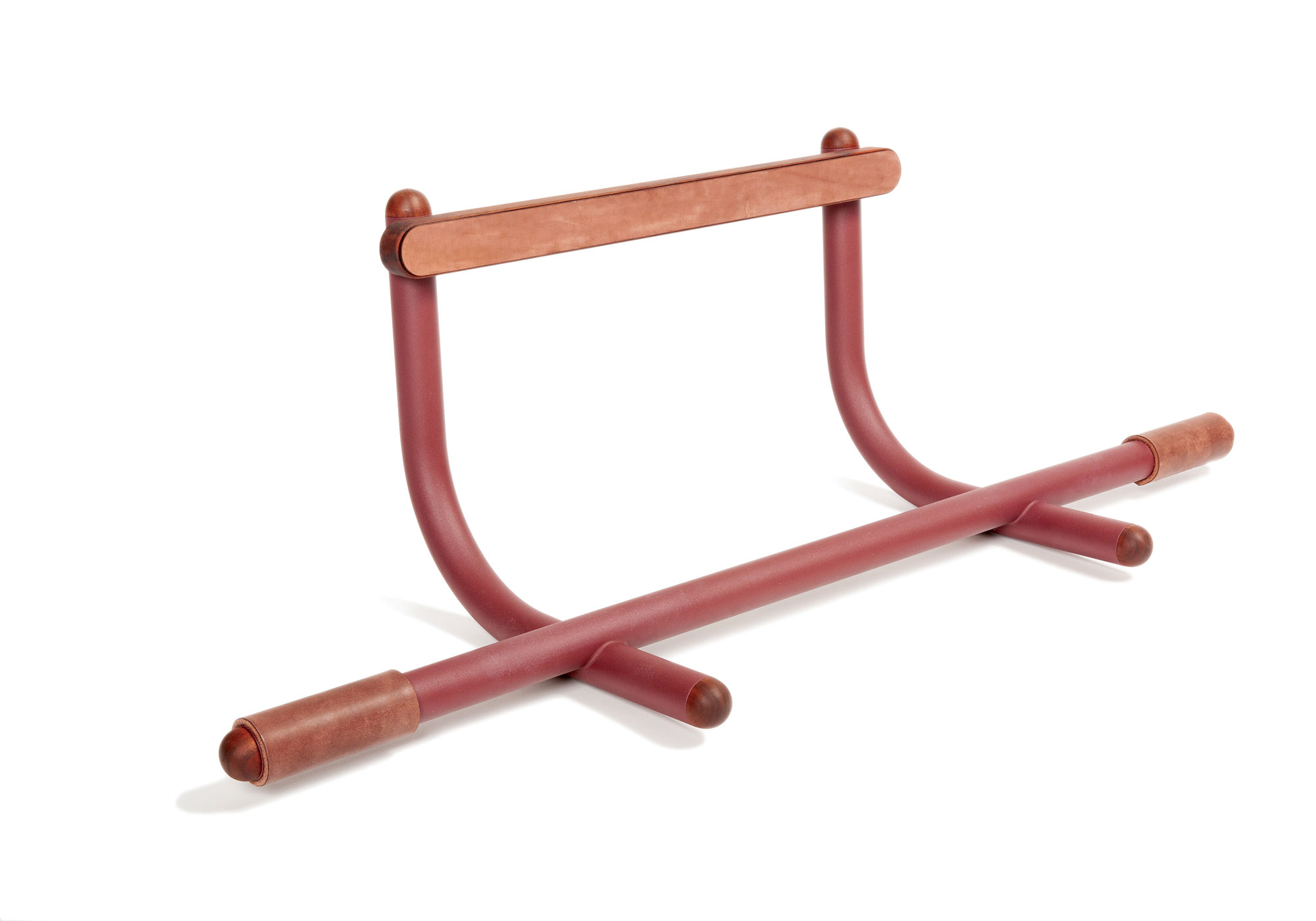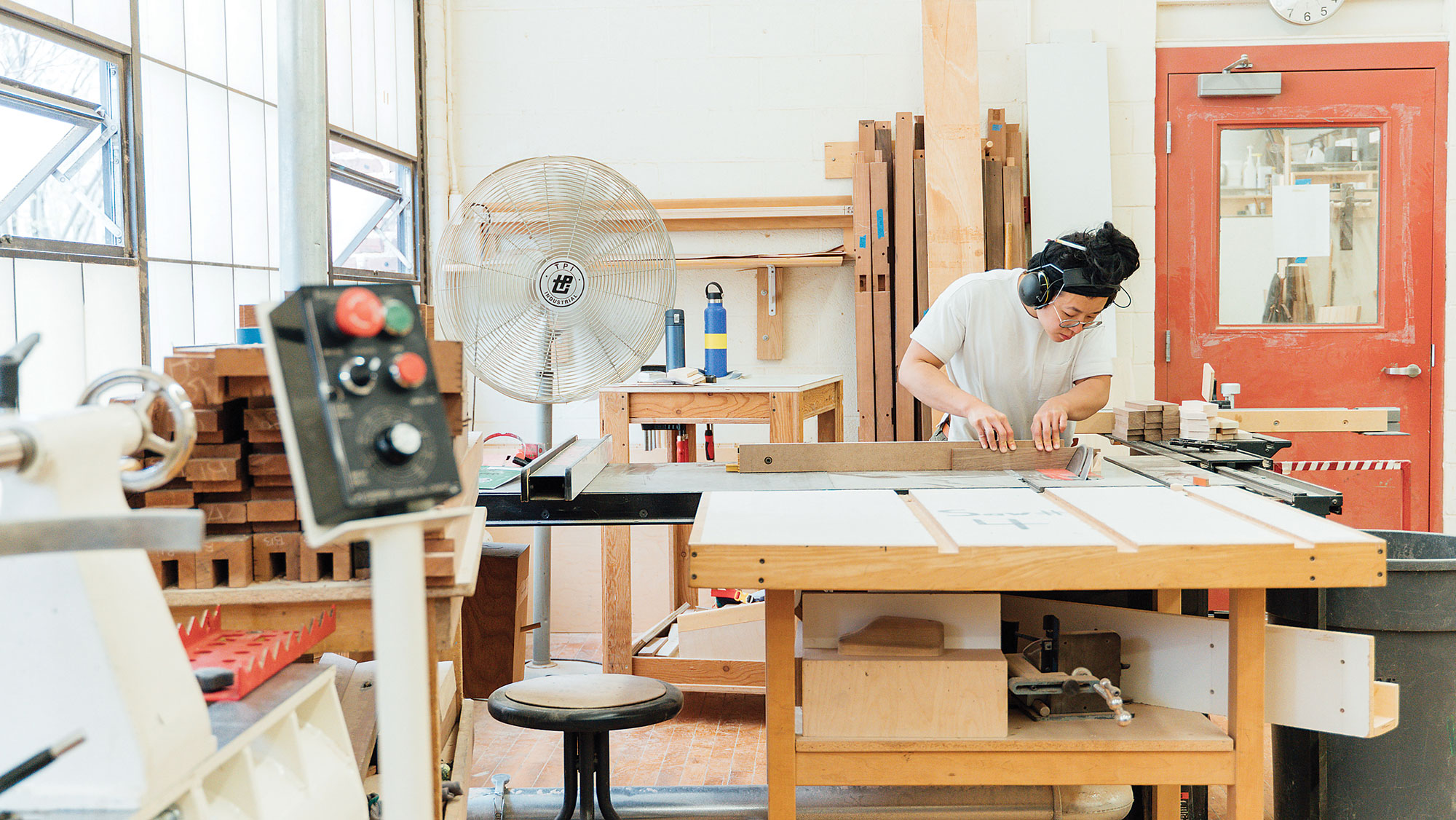Work in Use
Work in Use
↑ Designer-woodworker, movement practicioner, and Work in Use founder Wu Hanyen demonstrates how to use the portable Jia Parallettes.
Photo: Nic Der
Let’s face it, exercise equipment may help us look and feel great, but it tends to be an eyesore in the living room. No wonder it often ends up stashed in the closet or basement, gathering dust.
Work in Use, a design studio in Providence, Rhode Island, offers an alternative: high-end movement tools handsome enough to double as minimalist furniture or sculpture. “I approach making each object so that it’s something you can have in your home and be proud of, instead of wanting to put it away when you’re not using it,” says designer-woodworker Wu Hanyen, 30, who launched the collection in 2019.

← Made with oiled walnut, Cordovan steel, and leather, the Lachi Pull Up Bar is easy to install over a door.
Photo: Nic Der
Wu, as she’s known professionally, took up gymnastics and movement classes when she was in her early 20s to help ease the back strain she experienced making furniture. Unhappy with the look and feel of mass-produced fitness gear, she started crafting her own, and eventually a product line was born. Her balance rails, pull-up bars, hand weights, gym rings, and parallettes come in warm, tactile combinations of wood, metal, leather, and rubber. Put to the test by Wu and her friends in the movement community, they also do the job.

These solid maple gymnastic Yuan Rings, which hang via nylon straps secured by cast-bronze buckles, can be displayed in the home rather than be hidden away after use. →
Photos: Nic Der
The supports of the cherry wood Ping Balance Rail perform double duty as yoga blocks. ↓

“There’s a fine balance between wanting to make something beautiful, but also wanting it to function in very specific ways,” Wu says. “For me, it’s about aesthetics, functionality, color palette, materials, and craft, and how all of these can come together.” She brings to her designs a heightened sensitivity to material and its relationship to the body – for example, considering which textured powder-coat finish on a balance rail best prevents a slip. She builds all prototypes herself; for the final product, she does the woodwork and usually delegates construction with metal and other materials to fabricators. Like strength training, she’ll continually hone a design for a better, evermore refined product. “Through an iterative process, you assert craft into your design, and design into your craft.”

↑ Wu Hanyen at work on a pair of Yuan Rings in her Providence, Rhode Island, studio.
Photo: Stephen Mason
Wu grew up in Taiwan and Texas. Though none of her family members were overtly artistic, relatives regularly gathered for meticulously prepared feasts. “A lot of care went into the way my aunt and grandmother would craft these meals,” she recalls. “That care and attention to detail are what I see myself putting into my work now.”
She majored in graphic design at the University of Texas, but fell in love with Scandinavian furniture during a summer studying in Copenhagen, Denmark, and switched her focus to woodworking. After graduation in 2012, she moved to New York City and became lead builder for Egg Collective, a furniture and lighting design company founded by Stephanie Beamer, Crystal Ellis, and Hillary Petrie. During her four years with the firm, Wu got to observe the ins and outs of running a successful design business. “I was in this very male-dominated industry – furniture and woodworking – where I would go to the lumberyard and not be treated the same. So it was nice to have [as bosses and friends] three badass women who were like, ‘This is what we do, and we’re doing it!’” Once she felt ready to pursue her own vision, Wu enrolled in the Rhode Island School of Design – mainly for the opportunity to explore a range of materials, such as glass, textiles, and rubber – and earned her MFA last year.

A new form of dumbbell, the stylish brass 2.5-, 4.5-, and 6.5-pound Yaling Hand Weights fit vertically in a maple stand.
Photos: Nic Der
Wu sees Work in Use as a way to holistically combine her two passion practices – movement and making – while commuting to Boston for her full-time job teaching at the Massachusetts College of Art and Design. “My next dream is to have my own movement space and to design tools that are more integrative to it.”
Do craft stories like this matter to you?
Become an American Craft Council member, receive our magazine, and support nonprofit craft publishing. Join a community of like-minded readers who are passionate about making, meet and buy the work of the country’s most talented artists at our shows, and help grow the number of lives craft has touched.





